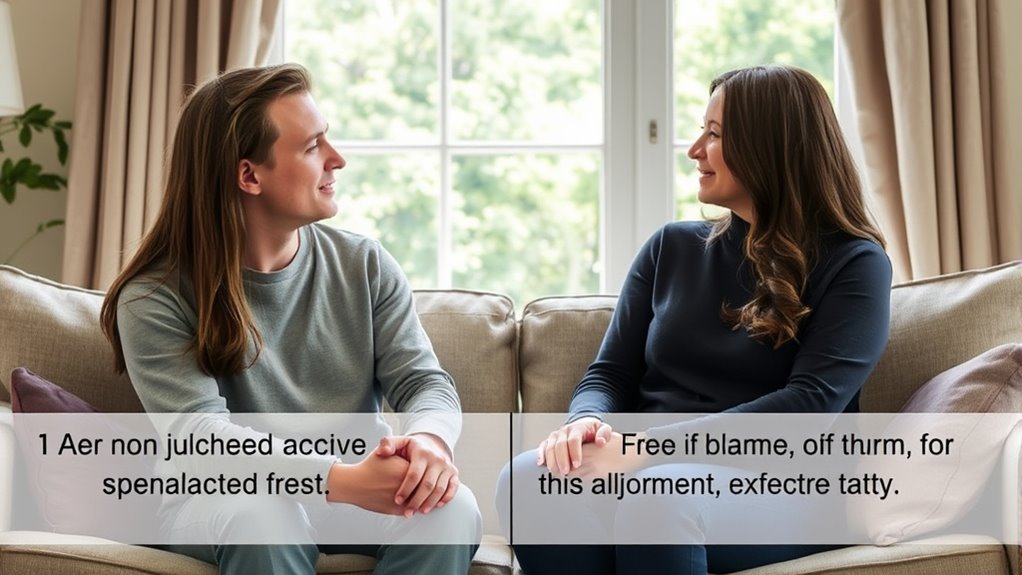To resolve conflicts without blame, focus on understanding each other’s perspectives with empathy and active listening. Avoid pointing fingers by using “I” statements to express your feelings clearly and non-judgmentally. Prioritize addressing the issue rather than blaming or attacking your partner. Create a respectful environment for honest conversation, and work together on finding solutions. If you want to learn practical steps to improve your communication, there’s more that can help strengthen your relationship.
Key Takeaways
- Focus on addressing issues rather than assigning blame to foster constructive dialogue.
- Practice active listening and empathy to understand your partner’s feelings without judgment.
- Create a safe, respectful environment that encourages honest communication and minimizes defensiveness.
- Collaborate on solutions by brainstorming together and emphasizing mutual accountability.
- Seek support from resources or professionals when conflicts become challenging to resolve alone.
Recognizing the Impact of Blame in Conflict

Blame often fuels conflict instead of resolving it, making it harder for both partners to find common ground. When you blame your partner, you’re likely engaging in blame avoidance, which avoids addressing the real issues and instead focuses on assigning fault. This behavior can quickly lead to defensiveness escalation, where each of you becomes more guarded and less open to understanding. Instead of working together, blame creates a cycle of accusations that deepen misunderstandings and hurt feelings. Recognizing this pattern is essential; it highlights how blame prevents progress and damages trust. By understanding the impact of blame, you can start to shift your focus away from fault-finding and toward constructive dialogue, paving the way for healthier, more effective conflict resolution. Additionally, understanding Fokos can help couples explore deeper insights into their interactions and promote healing. Developing emotional awareness can further assist in recognizing when blame is being used as a defense mechanism, allowing for more mindful responses. Cultivating communication skills is also vital in fostering understanding and reducing blame during conflicts. Incorporating mindfulness practices can support couples in staying present and reducing reactive behaviors during disagreements.
Cultivating Empathy to Understand Each Other’s Perspectives

To truly understand each other’s perspectives, you need to practice active listening by giving your full attention and reflecting back what you hear. Sharing your personal feelings openly helps your partner see where you’re coming from and fosters connection. When both of you commit to these techniques, empathy naturally grows, easing conflict without blame. Being aware of signs of distress in each other can also help prevent misunderstandings and facilitate compassionate communication.
Active Listening Techniques
Active listening is a essential skill that fosters empathy and helps you genuinely understand your partner’s perspective. You do this by paying close attention to non-verbal cues like body language, tone, and facial expressions, which often reveal feelings words can’t express. Practice reflective listening by paraphrasing what your partner says, such as, “What I hear you saying is…” This shows you’re engaged and truly trying to understand, not just waiting to respond. Avoid interrupting and focus on creating a safe space for open dialogue. Active listening encourages your partner to feel heard and validated, reducing defensiveness. Over time, mastering these techniques strengthens your connection and helps resolve conflicts without blame, fostering mutual respect and understanding. Incorporating industry trends can also help you stay current on effective communication strategies.
Sharing Personal Feelings
Have you ever noticed how sharing your personal feelings can deepen understanding between you and your partner? When you express vulnerability, you invite empathy and trust. To do this effectively, consider these steps:
- Speak honestly about your emotions without blame.
- Share your boundaries to clarify what feels safe for you.
- Use “I” statements to focus on your experience.
- Listen actively when your partner shares theirs.
- Incorporate emotional awareness to better understand your own feelings and respond thoughtfully. Developing contrast ratio awareness can help you perceive subtle emotional cues, fostering deeper connection in your relationship. Additionally, understanding mindfulness techniques from various practices can bring new perspectives to conflict resolution.
Focusing on the Issue, Not the Person

When conflicts arise, it’s easy to focus on accusing your partner rather than addressing the actual issue at hand. To keep conversations productive, prioritize focusing on the problem, not the person. Use apology strategies that acknowledge your role without assigning blame, which helps keep the discussion constructive. Timing matters—choose the right moment to talk about sensitive topics, avoiding heated moments or distractions. When you stay centered on the issue, you prevent the conversation from spiraling into personal attacks. Remember, it’s about solving the problem together, not pointing fingers. By maintaining this focus, you create a safe environment where both of you can express concerns without feeling attacked, making resolution easier and more respectful. Additionally, understanding the importance of seasonal variations can help you choose the appropriate time and setting for discussions, ensuring they are more effective. Recognizing the power of instant feedback can also facilitate more open and timely communication during conflicts. Being aware of emotional triggers can help prevent escalation and foster a more understanding atmosphere. Incorporating an awareness of personality traits, such as those identified by tools like the 16PF or MBTI, can further enhance your ability to navigate disagreements with empathy and insight.
Using “I” Statements to Communicate Feelings

Focusing on the issue helps keep conversations respectful, but expressing your feelings clearly is equally important to foster understanding. Using “I” statements allows you to communicate with emotional honesty while maintaining respectful dialogue. When you share your feelings, picture these images:
- You’re gently placing your feelings on the table, like a fragile gift.
- Your words flow smoothly, avoiding blame or criticism.
- Your partner listens with open eyes, feeling your sincerity.
- A shared moment of understanding blossoms between you.
- Practicing emotional awareness can help you better identify and articulate your feelings. Incorporating effective communication techniques, such as “I” statements, can further enhance mutual understanding and reduce misunderstandings during conflicts. Recognizing interpersonal dynamics common in BPD can help you navigate sensitive interactions more effectively. This approach helps prevent defensiveness and keeps the conversation constructive. It encourages honesty about your emotions without accusing, making it easier for both of you to connect and resolve conflicts peacefully. Using “I” statements transforms confrontation into collaboration. Additionally, incorporating calming techniques like eye patches can help reduce stress and create a more relaxed environment for discussion.
Developing Active Listening Skills

Active listening is essential for understanding your partner’s perspective and building trust. To do this effectively, pay attention to non-verbal cues like body language, facial expressions, and tone of voice. These cues often reveal what words might miss. Practice reflective listening by paraphrasing what your partner says, which shows you’re engaged and genuinely understanding their feelings. For example, say, “What I hear you saying is…” This encourages your partner to clarify or expand, fostering open communication. Avoid interrupting or jumping to conclusions. Instead, focus on being present and attentive. Developing these skills helps you create a safe space where both of you can express yourselves honestly without blame, making conflicts easier to resolve collaboratively. Being aware of cookie consent preferences can also help in maintaining clear and respectful communication boundaries. Additionally, understanding the support hours of resources like mental health services or counseling can be beneficial if conflicts become particularly challenging.
Collaborating on Solutions and Moving Forward

Once you and your partner understand each other’s perspectives, collaborating on solutions becomes a productive way to move forward. You can brainstorm together, focusing on creative compromises that satisfy both sides. Imagine:
Understanding each other’s views fosters productive collaboration and creative compromises for mutual solutions.
- Sitting face-to-face, exchanging ideas with openness.
- Sketching out options on a shared notepad.
- Weighing the pros and cons of each solution.
- Agreeing on a plan that reflects mutual accountability.
Frequently Asked Questions
How Can Couples Rebuild Trust After Blame Has Damaged Their Relationship?
When trust has been damaged by blame, you can focus on trust rebuilding by open communication and showing consistent honesty. Prioritize creating emotional safety where both of you feel heard and respected. Apologize sincerely, acknowledge your partner’s feelings, and commit to positive change. Over time, these actions help rebuild trust, fostering a secure environment where both of you can heal and strengthen your relationship.
What Are Practical Steps to Prevent Blame From Recurring During Conflicts?
To prevent blame from recurring during conflicts, focus on improving your communication skills and empathy building. Practice active listening, so you truly understand your partner’s perspective, and avoid accusations. Use “I” statements to express your feelings without blaming. Regularly check in with your partner, fostering openness and trust. These steps help create a respectful environment where conflicts are addressed constructively, reducing the chances of blame and strengthening your relationship.
How Does Cultural Background Influence Blame and Conflict Resolution Styles?
Cultural perceptions greatly influence how you approach blame and conflict styles. In some cultures, direct confrontation and individual accountability are valued, leading you to openly address issues. In others, harmony and indirect communication shape your style, causing you to avoid blame and prioritize consensus. Recognizing these differences helps you adapt your conflict resolution approach, making it easier to navigate disagreements without escalating blame or misunderstandings.
Can Therapy Effectively Help Couples Stop Blaming Each Other?
Ever wonder if therapy can truly help you stop blaming each other? It can, when you focus on developing emotional awareness and communication skills. A skilled therapist guides you to understand your feelings and express them constructively, reducing blame. Are you willing to open up and work together? With patience and the right support, therapy can transform conflicts into opportunities for connection and growth.
How Do Individual Past Experiences Affect Blame Tendencies in Relationships?
Your past trauma and attachment styles markedly influence your tendency to blame in relationships. If you’ve experienced hurt or neglect, you might unconsciously project blame onto your partner to protect yourself. Secure attachment fosters understanding, while insecure styles may lead to more blame. Recognizing these patterns helps you break free from automatic blame, allowing healthier interactions. By exploring your past, you can develop empathy and reduce blame, strengthening your relationship.
Conclusion
By letting go of blame, you open the door to understanding and healing, like clearing away fog to see each other clearly. When you listen with empathy and speak with honesty, your words become bridges, not barriers, guiding you toward shared solutions. Remember, conflict is a dance you can lead with patience and compassion, turning storms into rainbows. Embrace this journey together, and watch your connection blossom into a resilient, harmonious love.









